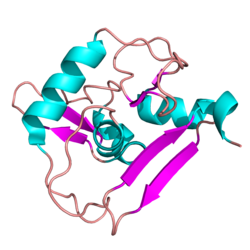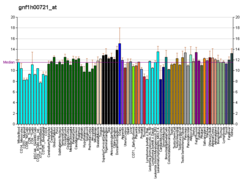Protein-coding gene in the species Homo sapiens
| PHF6 |
|---|
 |
| Available structures |
|---|
| PDB | Ortholog search: PDBe RCSB |
|---|
| List of PDB id codes |
|---|
4NN2, 4R7A |
|
|
| Identifiers |
|---|
| Aliases | PHF6, BFLS, BORJ, CENP-31, PHD finger protein 6 |
|---|
| External IDs | OMIM: 300414; MGI: 1918248; HomoloGene: 12375; GeneCards: PHF6; OMA:PHF6 - orthologs |
|---|
| Gene location (Human) |
|---|
 | | Chr. | X chromosome (human)[1] |
|---|
| | Band | Xq26.2 | Start | 134,373,288 bp[1] |
|---|
| End | 134,428,791 bp[1] |
|---|
|
| Gene location (Mouse) |
|---|
 | | Chr. | X chromosome (mouse)[2] |
|---|
| | Band | X|X A5 | Start | 52,001,143 bp[2] |
|---|
| End | 52,045,820 bp[2] |
|---|
|
| RNA expression pattern |
|---|
| Bgee | | Human | Mouse (ortholog) |
|---|
| Top expressed in | - corpus epididymis
- oocyte
- endothelial cell
- germinal epithelium
- secondary oocyte
- ganglionic eminence
- pancreatic epithelial cell
- palpebral conjunctiva
- Brodmann area 23
- caput epididymis
|
| | Top expressed in | - hand
- superior cervical ganglion
- medial ganglionic eminence
- maxillary prominence
- trigeminal ganglion
- median eminence
- secondary oocyte
- neural tube
- pineal gland
- cumulus cell
|
| | More reference expression data |
|
|---|
| BioGPS |  | | More reference expression data |
|
|---|
|
| Gene ontology |
|---|
| Molecular function | - tubulin binding
- enzyme binding
- scaffold protein binding
- DNA binding
- ribonucleoprotein complex binding
- histone binding
- phosphoprotein binding
- histone deacetylase binding
- protein binding
- metal ion binding
- RNA binding
- DNA-binding transcription repressor activity, RNA polymerase II-specific
- sequence-specific DNA binding
| | Cellular component | - nucleolus
- chromosome, centromeric region
- nucleus
- kinetochore
- nucleoplasm
- chromosome
| | Biological process | - regulation of transcription, DNA-templated
- transcription, DNA-templated
- negative regulation of transcription by RNA polymerase II
- blastocyst hatching
| | Sources:Amigo / QuickGO |
|
| Orthologs |
|---|
| Species | Human | Mouse |
|---|
| Entrez | | |
|---|
| Ensembl | | |
|---|
| UniProt | | |
|---|
| RefSeq (mRNA) | |
|---|
NM_032458
NM_001015877
NM_032335 |
| |
|---|
| RefSeq (protein) | |
|---|
NP_001015877
NP_115711
NP_115834 |
| |
|---|
| Location (UCSC) | Chr X: 134.37 – 134.43 Mb | Chr X: 52 – 52.05 Mb |
|---|
| PubMed search | [3] | [4] |
|---|
|
| Wikidata |
| View/Edit Human | View/Edit Mouse |
|
PHD finger protein 6 is a protein that in humans is encoded by the PHF6 gene.[5][6]
This gene is a member of the plant homeodomain (PHD)-like finger (PHF) family. It encodes a protein with two atypical PHD-type zinc finger domains, indicating a potential role in transcriptional regulation, that localizes to the nucleolus.[6]
Mutations
Mutations affecting the coding region of this gene or the splicing of the transcript have been associated with Börjeson-Forssman-Lehmann syndrome (BFLS), a disorder characterized by mental retardation, epilepsy, hypogonadism, hypometabolism, obesity, swelling of subcutaneous tissue of the face, narrow palpebral fissures, and large ears. Alternate transcriptional splice variants, encoding different isoforms, have been characterized.[6]
The PHF6 gene in humans is also frequently mutated in human hematological malignancies, including T-cell acute lymphoblastic Leukemia (T-ALL)[7] and Acute Myeloid Leukemia (AML)[8] and at least two BFLS patients have developed leukemia or lymphoma.[9] PHF6 has been shown to be important for the regulation of blood stem and progenitor cells[10][11][12][13] and loss of PHF6 protein synergizes with over-expression of the TLX3 protein to cause lymphoid neoplasms.[11]
References
- ^ a b c GRCh38: Ensembl release 89: ENSG00000156531 – Ensembl, May 2017
- ^ a b c GRCm38: Ensembl release 89: ENSMUSG00000025626 – Ensembl, May 2017
- ^ "Human PubMed Reference:". National Center for Biotechnology Information, U.S. National Library of Medicine.
- ^ "Mouse PubMed Reference:". National Center for Biotechnology Information, U.S. National Library of Medicine.
- ^ Lower KM, Turner G, Kerr BA, Mathews KD, Shaw MA, Gedeon AK, et al. (December 2002). "Mutations in PHF6 are associated with Börjeson-Forssman-Lehmann syndrome". Nature Genetics. 32 (4): 661–5. doi:10.1038/ng1040. PMID 12415272. S2CID 10274037.
- ^ a b c "Entrez Gene: PHF6 PHD finger protein 6".
- ^ Van Vlierberghe P, Palomero T, Khiabanian H, Van der Meulen J, Castillo M, Van Roy N, et al. (April 2010). "PHF6 mutations in T-cell acute lymphoblastic leukemia". Nature Genetics. 42 (4): 338–42. doi:10.1038/ng.542. PMC 2847364. PMID 20228800.
- ^ Van Vlierberghe P, Patel J, Abdel-Wahab O, Lobry C, Hedvat CV, Balbin M, et al. (January 2011). "PHF6 mutations in adult acute myeloid leukemia". Leukemia. 25 (1): 130–4. doi:10.1038/leu.2010.247. PMC 3878659. PMID 21030981.
- ^ Chao MM, Todd MA, Kontny U, Neas K, Sullivan MJ, Hunter AG, et al. (October 2010). "T-cell acute lymphoblastic leukemia in association with Börjeson-Forssman-Lehmann syndrome due to a mutation in PHF6". Pediatric Blood & Cancer. 55 (4): 722–4. doi:10.1002/pbc.22574. PMC 2933084. PMID 20806366.
- ^ Wendorff AA, Quinn SA, Rashkovan M, Madubata CJ, Ambesi-Impiombato A, Litzow MR, et al. (March 2019). "Phf6 Loss Enhances HSC Self-Renewal Driving Tumor Initiation and Leukemia Stem Cell Activity in T-ALL". Cancer Discovery. 9 (3): 436–451. doi:10.1158/2159-8290.CD-18-1005. PMC 6425751. PMID 30567843.
- ^ a b McRae HM, Garnham AL, Hu Y, Witkowski MT, Corbett MA, Dixon MP, et al. (April 2019). "PHF6 regulates hematopoietic stem and progenitor cells and its loss synergizes with expression of TLX3 to cause leukemia". Blood. 133 (16): 1729–1741. doi:10.1182/blood-2018-07-860726. PMC 6695515. PMID 30755422.
- ^ Miyagi S, Sroczynska P, Kato Y, Nakajima-Takagi Y, Oshima M, Rizq O, et al. (June 2019). "The chromatin-binding protein Phf6 restricts the self-renewal of hematopoietic stem cells". Blood. 133 (23): 2495–2506. doi:10.1182/blood.2019000468. PMID 30917958.
- ^ Hsu YC, Chen TC, Lin CC, Yuan CT, Hsu CL, Hou HA, et al. (August 2019). "Phf6-null hematopoietic stem cells have enhanced self-renewal capacity and oncogenic potentials". Blood Advances. 3 (15): 2355–2367. doi:10.1182/bloodadvances.2019000391. PMC 6693005. PMID 31395598.
Further reading
- Nagase T, Nakayama M, Nakajima D, Kikuno R, Ohara O (April 2001). "Prediction of the coding sequences of unidentified human genes. XX. The complete sequences of 100 new cDNA clones from brain which code for large proteins in vitro". DNA Research. 8 (2): 85–95. doi:10.1093/dnares/8.2.85. PMID 11347906.
- Baumstark A, Lower KM, Sinkus A, Andriuskeviciute I, Jurkeniene L, Gécz J, Just W (April 2003). "Novel PHF6 mutation p.D333del causes Börjeson-Forssman-Lehmann syndrome". Journal of Medical Genetics. 40 (4): 50e–50. doi:10.1136/jmg.40.4.e50. PMC 1735415. PMID 12676923.
- Dattani MT (December 2003). "Borjeson-Forssman-Lehmann syndrome: a novel pituitary phenotype due to mutation in a novel gene". Journal of Pediatric Endocrinology & Metabolism. 16 (9): 1207–9. doi:10.1515/jpem.2003.16.9.1207. PMID 14714741. S2CID 45542882.
- Birrell G, Lampe A, Richmond S, Bruce SN, Gécz J, Lower K, et al. (December 2003). "Borjeson-Forssman-Lehmann syndrome and multiple pituitary hormone deficiency". Journal of Pediatric Endocrinology & Metabolism. 16 (9): 1295–300. doi:10.1515/jpem.2003.16.9.1295. PMID 14714754. S2CID 10327867.
- Turner G, Lower KM, White SM, Delatycki M, Lampe AK, Wright M, et al. (March 2004). "The clinical picture of the Börjeson-Forssman-Lehmann syndrome in males and heterozygous females with PHF6 mutations". Clinical Genetics. 65 (3): 226–32. doi:10.1111/j.0009-9163.2004.00215.x. PMID 14756673. S2CID 24602739.
- Lower KM, Solders G, Bondeson ML, Nelson J, Brun A, Crawford J, et al. (October 2004). "1024C> T (R342X) is a recurrent PHF6 mutation also found in the original Börjeson-Forssman-Lehmann syndrome family". European Journal of Human Genetics. 12 (10): 787–9. doi:10.1038/sj.ejhg.5201228. PMID 15241480. S2CID 7327686.
- Vallée D, Chevrier E, Graham GE, Lazzaro MA, Lavigne PA, Hunter AG, Picketts DJ (October 2004). "A novel PHF6 mutation results in enhanced exon skipping and mild Börjeson-Forssman-Lehmann syndrome". Journal of Medical Genetics. 41 (10): 778–83. doi:10.1136/jmg.2004.020370. PMC 1735599. PMID 15466013.
- Andersen JS, Lam YW, Leung AK, Ong SE, Lyon CE, Lamond AI, Mann M (January 2005). "Nucleolar proteome dynamics". Nature. 433 (7021): 77–83. Bibcode:2005Natur.433...77A. doi:10.1038/nature03207. PMID 15635413. S2CID 4344740.
- Crawford J, Lower KM, Hennekam RC, Van Esch H, Mégarbané A, Lynch SA, et al. (March 2006). "Mutation screening in Borjeson-Forssman-Lehmann syndrome: identification of a novel de novo PHF6 mutation in a female patient". Journal of Medical Genetics. 43 (3): 238–43. doi:10.1136/jmg.2005.033084. PMC 2563250. PMID 15994862.
- Olsen JV, Blagoev B, Gnad F, Macek B, Kumar C, Mortensen P, Mann M (November 2006). "Global, in vivo, and site-specific phosphorylation dynamics in signaling networks". Cell. 127 (3): 635–48. doi:10.1016/j.cell.2006.09.026. PMID 17081983. S2CID 7827573.
External links
This article incorporates text from the United States National Library of Medicine, which is in the public domain.
(1) Basic domains |
|---|
| (1.1) Basic leucine zipper (bZIP) | |
|---|
| (1.2) Basic helix-loop-helix (bHLH) | | Group A | |
|---|
| Group B | |
|---|
Group C
bHLH-PAS | |
|---|
| Group D | |
|---|
| Group E | |
|---|
Group F
bHLH-COE | |
|---|
|
|---|
| (1.3) bHLH-ZIP | |
|---|
| (1.4) NF-1 | |
|---|
| (1.5) RF-X | |
|---|
| (1.6) Basic helix-span-helix (bHSH) | |
|---|
|
|
(2) Zinc finger DNA-binding domains |
|---|
| (2.1) Nuclear receptor (Cys4) | | subfamily 1 | |
|---|
| subfamily 2 | |
|---|
| subfamily 3 | |
|---|
| subfamily 4 | |
|---|
| subfamily 5 | |
|---|
| subfamily 6 | |
|---|
| subfamily 0 | |
|---|
|
|---|
| (2.2) Other Cys4 | |
|---|
| (2.3) Cys2His2 | |
|---|
| (2.4) Cys6 | |
|---|
| (2.5) Alternating composition | |
|---|
| (2.6) WRKY | |
|---|
|
|
|
(4) β-Scaffold factors with minor groove contacts |
|---|
|
|
(0) Other transcription factors |
|---|
|
|
see also transcription factor/coregulator deficiencies |
 | This article on a gene on the human X chromosome and/or its associated protein is a stub. You can help Wikipedia by expanding it. |




















